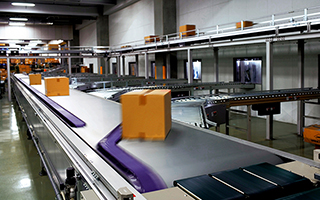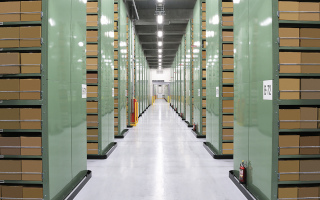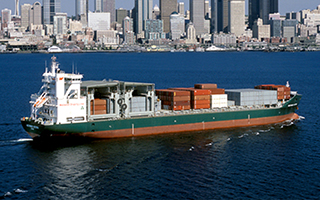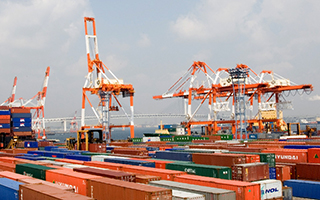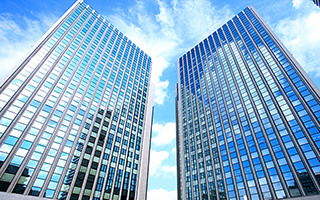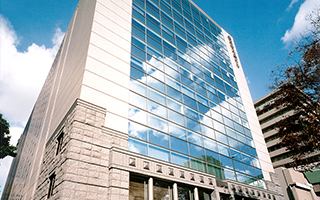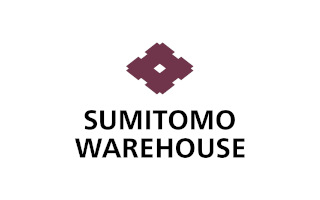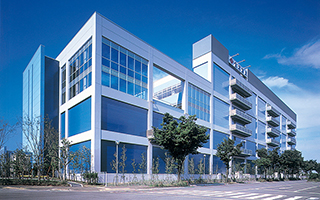Response to the Recommendations of the Task Force on Climate-Related Financial Disclosures (TCFD)
Based on the recognition that measures against climate change are one of the most important issues in our business, the Sumitomo Warehouse Group is steadily and continuously working to preserve the environment by reducing the environmental impact of our corporate activities in order to contribute to the realization of a sustainable society.
As part of this effort, we will analyze the risks and opportunities to our business posed by climate change in accordance with the information disclosure framework set forth by the TCFD and strive to reduce risks and expand business opportunities while proactively disclosing information.
Governance
The company recognizes climate change to be a key management issue. Under the supervision of the Board of Directors, Sustainability Committee, chaired by the President, has established a system for identifying climate change-related issues, making management decisions, and executing business operations.
The Board of Directors receives reports from Sustainability Committee, thereby putting in place a system to ensure that the Board of Directors appropriately oversees efforts to address management issues related to environmental conservation, including climate change. The Board of Directors also makes decisions on important management matters.
Sustainability Committee consists of the chairman, vice chairman, and committee members. It investigates and formulates various measures, systems, and rules for the Sumitomo Warehouse Group's compliance, risk management, internal control over financial reporting, information security, human rights, occupational health and safety, the quality improvement of services we provided by our group and environmental conservation. Measures to be taken are discussed as instructed by the Sustainability Committee in the Internal Control Subcommittee, CSIRT Subcommittee (SWC-CSIRT), Human Rights Subcommittee, Safety and Quality Subcommittee and Environmental Subcommittee which were established under the Sustainability Committee. Matters to be discussed by the Sustainability Committee are implemented by resolution of the Board of Directors as necessary.
Regarding issues related to climate change, the Environmental Subcommittee, one of the subcommittees that comprises the committee, identifies risks and reflects them in strategies with the participation of the Business Promotion Department, which is in charge of environmental conservation, and deploys them throughout the company to resolve issues. In addition, the subcommittee reports annually to Sustainability Committee and Board of Directors on environment-related issues and targets for initiatives.
Sustainability Committee Structure Diagram

Organization
| Chairman | Chief Executive Officer |
|---|---|
| Vice Chairman | Managing Executive Officers |
| Member |
General Manager, Business Promotion Department General Manager, Audit Department General Manager, General Affairs Department General Manager, Finance & Accounting Department General Manager, Marketing Management Department General Manager, Marine Department General Manager, Overseas Business Department General Manager, Affiliated Companies Department General Manager, Development Department General Manager, Information Systems Department |
Strategy
The point in time for the analysis was made 2030, and the analysis covered the Logistics business and the real estate business of the Sumitomo Warehouse Co., Ltd., and the logistics business of Enshu Truck Co., Ltd. The analysis was conducted in the steps of consolidating risks and opportunities, summarizing social changes and framing their impact on business, and examining countermeasures.
Two scenarios are hypothesized: a below 1.5°C scenario, which aims to realize a decarbonized society, and a 4°C scenario, in which no climate change measures are taken and physical risks are actualized. Scenarios set out by external organizations are referenced as necessary in order to organize social changes and used in the analysis of financial impact.
Analysis method
| 1.Consolidate risks and opportunities | 2.Summarize social changes and frame their impact on business | 3.Examine countermeasures |
|---|---|---|
| Examine potential risks and opportunities for the company and Enshu Truck's business due to climate change and identify the items that have a large impact | Hypothesize social changes in 2030 and identify how they may affect | Examine measures to respond to social changes based on their impact on business |
Scenario hypotheses
| Scenario | Summary | Main reference scenario |
|---|---|---|
| Below 1.5°C scenario | In order to limit the increase in global average temperature to below 1.5°C above pre-industrial levels, each country strengthens policies and regulations beyond the 2°C scenario, such as aiming for net zero GHG emissions by 2050, and social awareness of the environment and climate change increases significantly compared to the current situation. |
|
| 4°C scenario | This scenario assumes that announced policies will be realized in addition to those already implemented and that policies and regulations are weaker than in the 1.5°C and 2°C scenarios. GHG emissions may also increase in the foreseeable future, and social awareness of the environment and climate change will remain on par with the current situation. |
|
Results of the examination of social change and response measures: Below 1.5°C scenario
In the below 1.5°C scenario, where society transitions to decarbonization, the impact of transition risks, such as enhanced taxation and regulation of GHG emissions and sharply increasing energy costs, is likely to be significant.
Financial impacts may include increased GHG emission costs, increased utility costs, and increased labor costs to comply with GHG reporting requirements.
The financial impact of quantifiable items was calculated, and there was found to be a significant impact due to the increase in GHG emission costs, and this was particularly true for Enshu Truck.
Possible measures to address this situation include promoting energy conservation and reducing costs by installing new photovoltaic power generation equipment, increasing the efficiency of work related to GHG emissions reporting, and acquisition of environmental certification etc. in real estate business. In addition to the above efforts, Enshu Truck may also introduce fuel-efficient vehicles and promote eco-driving.
While these measures will somewhat mitigate the impact on our business, we will enhance our resilience to climate change and create value in response to environmental changes by continuously monitoring future changes in the environment and expanding our quantitative analysis as appropriate.
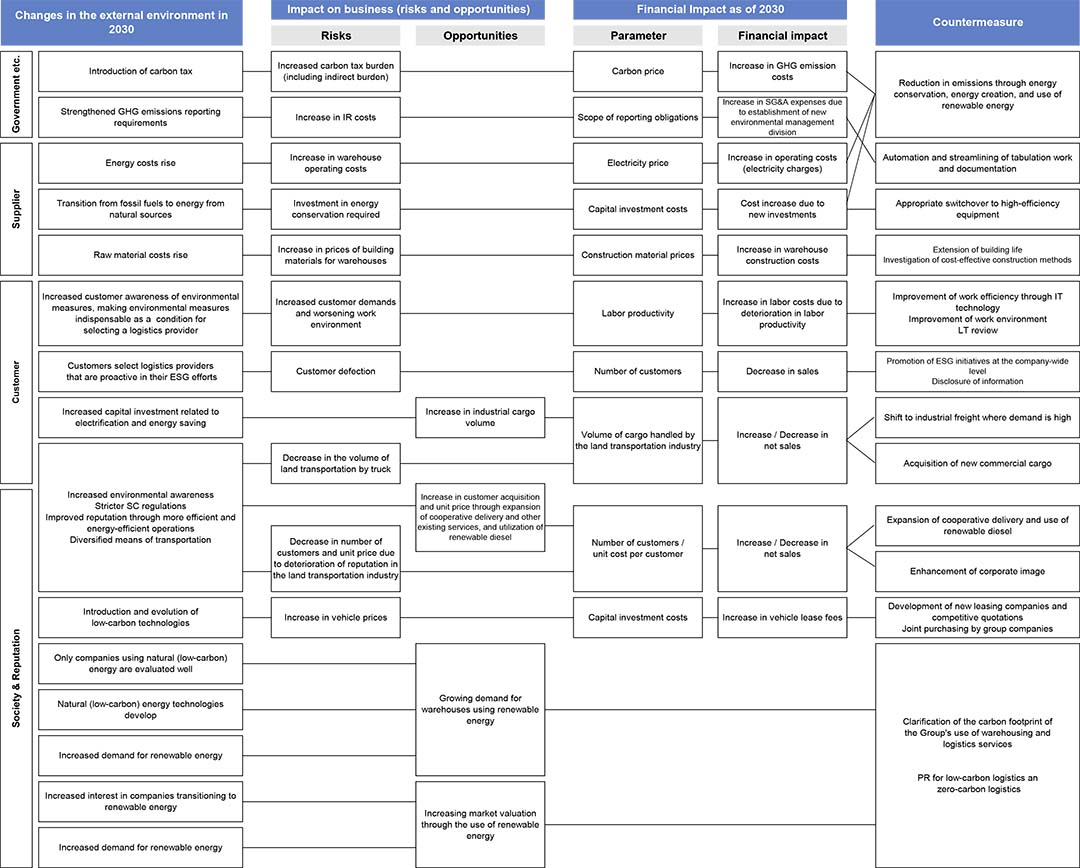
Results of the examination of social change and response measures: 4°C scenario
In the 4°C scenario, where climate change measures are not taken and physical risks are actualized, extreme weather events such as typhoons and floods increase, and the working environment deteriorates due to rising temperatures.
Financial impacts include increased fuel costs, increased repair costs and insurance premiums due to the severity of natural disasters, decreased sales due to business shutdowns, and increased costs due to labor shortages resulting from the deteriorating labor environment.
As a result of calculating the financial impact of quantifiable items, we found that the decline in sales due to labor shortages has a relatively large impact. In addition to the decrease in sales due to the suspension of operations, Enshu Truck was also found to experience the significant impact of increased costs due to soaring fuel prices.
Possible measures to deal with this situation include promoting energy conservation and improving the working environment. In addition to the above efforts, Enshu Truck could introduce fuel-efficient vehicles, promote eco-driving, and secure alternative routes and means of transportation to enable the continuation of operations in the event of a disaster.
While these measures will somewhat mitigate the impact on our business, we will enhance our resilience to climate change and create value in response to environmental changes by continuously monitoring future changes in the environment and expanding our quantitative analysis as appropriate.
Results of the examination of social change and response measures: 4°C scenario(Enlarged Figure)
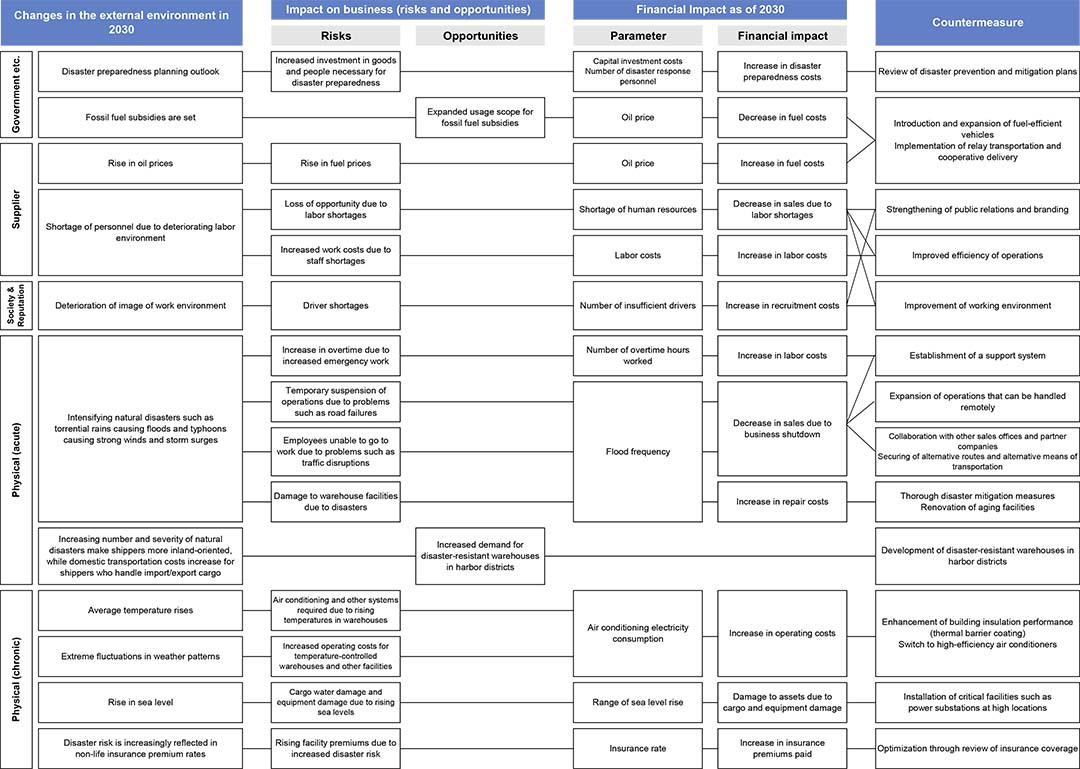
Risk management
Based on the results of periodic internal and external surveys, the Environmental Subcommittee of Sustainability Committee identifies and evaluates climate-related risks about which we should be aware, shares the identified and evaluated risks throughout the company, and reflects them in strategy.
Risk management for the entire Sumitomo Warehouse Group is conducted by the Internal Control Subcommittee, a subordinate body of Sustainability Committee. We have integrated our company-wide risk management system and climate change-related risk management system by establishing, through Sustainability Committee, a system of collaboration between the Environmental Subcommittee, which examines measures related to climate change, and the Internal Control Subcommittee, which examines measures related to risk management.
The Internal Control Subcommittee reports to Sustainability Committee on important risk management matters on a case-by-case basis and on the status of environmental regulatory compliance annually.
Indicators and targets
Based on the results of the scenario analysis, we will set indicators and targets to be used in line with our strategy and risk management and work to achieve them. In addition, we will promote the disclosure of actual results against targets and GHG emissions by Scope.
| Indicators | Targets | Boundary |
|---|---|---|
| GHG emissions | Aim to reduce GHG emissions of Scopes 1 and 2 on a non-consolidated basis by 50% from the FY2018 level by FY2030. | The Sumitomo Warehouse Co.,ltd. |

